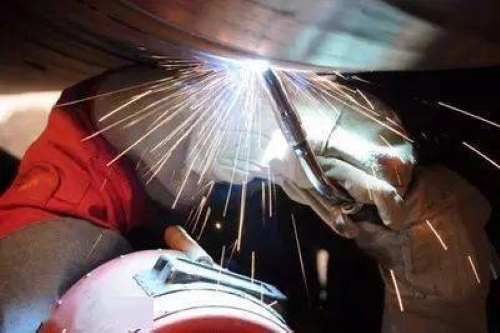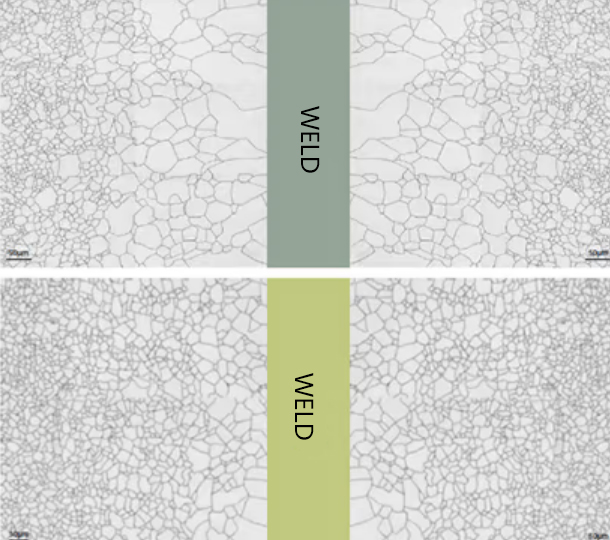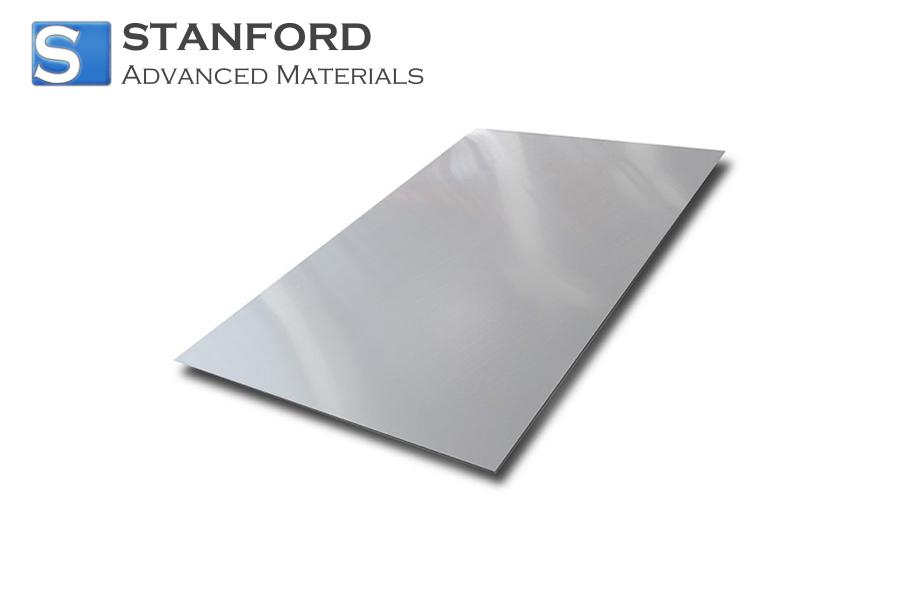The Effect Of Niobium Addition In Welding
1. Niobium is used as an alloying element to improve the welding performance in stainless steel.
--Let us review the effect.
Niobium is added to certain austenitic stainless steels, such as steel 347, to increase resistance to intergranular corrosion. This is particularly important during welding.

The reason is that niobium reacts with carbon to form niobium carbide (NbC), thereby preventing carbon from bonding with chromium to form chromium carbides (Cr23C6). Chromium carbides can lead to intergranular corrosion, which can significantly affect material integrity.
By forming niobium carbide, niobium effectively prevents this process and thus improves the corrosion resistance of the weld and the heat‐affected zone (HAZ).
Therefore, niobium-alloyed stainless steels are used in high-performance environments such as heat exchangers, pressure vessels and components that are exposed to high temperatures and aggressive chemical conditions.
-This effect has been demonstrated in several experiments.
Several studies have confirmed the effect of niobium in welding applications. For example, the role of niobium in the heat‐affected zone (HAZ) was analysed using electron backscatter diffraction (EBSD) to examine the grain structure in welded joints. The investigations indicate that the addition of niobium causes grain refinement in the HAZ, thereby reducing the extent of the coarse-grained zone. Finer grains in the HAZ result in an improved microstructure and toughness, which makes the welded material more resistant to failure under load.

Fig. 1 Comparison of welding of stainless steel with varied niobium additions (the upper specimen contains a lower niobium addition than the lower one).
Source:
"The State of the Art of Long Distance Gas Pipeline in China". Chengjia Shang - IGRC - Rio 2017
Research data from projects such as the CBMM cooperation in Moscow indicate that steels with a higher niobium content have a greater tolerance for increased heat input during welding. Consequently, the material withstands thermal welding cycles more effectively and weld reliability is maintained.
2. Niobium Alloying and Stainless Steel – Mixed Welding Technology
-Importance and challenges of dissimilar metal welding
Niobium alloys and stainless steel are frequently welded together in industries where both sets of performance properties are required. The combination of niobium’s high-temperature performance, corrosion resistance and superconductivity with the strength and cost efficiency of stainless steel renders the welding of dissimilar metals attractive. Welding these two materials is challenging due to differing physical, chemical and metallurgical properties.
- Different thermal properties: The coefficient of thermal expansion of niobium alloys (7.3×10⁻⁶/°C) differs significantly from that of stainless steel (17.3×10⁻⁶/°C), thereby causing residual stresses.
- Metallurgical incompatibility: There is a risk of forming brittle intermetallic compounds such as Fe₂Nb and Cr₂Nb.
- Oxidation sensitivity: Niobium is highly sensitive to oxidation at elevated temperatures, thereby requiring strict protective measures.
- Weld bead dilution control: Controlling the composition in the molten pool is challenging.
-Welding methods – Comparison and selection
-Traditional welding methods
When welding niobium alloys with stainless steel, selecting the appropriate welding method is essential. The following is a list of traditional welding methods.
|
Welding Method |
Advantages |
Limitations |
Applicable Scenarios |
|
TIG (Tungsten Inert Gas) |
Simple equipment, flexible operation |
High heat input, significant distortion |
Thin plate butt joints, simple structures |
|
EBW (Electron Beam Welding) |
High depth-to-width ratio, limited heat-affected zone |
Requires a vacuum environment, costly equipment |
High precision components, aerospace applications |
|
LBW (Laser Beam Welding) |
Precise heat input, high automation |
Requires precise alignment |
Thin plates, precise joints |
-Advanced welding technologies
Advanced welding techniques such as friction welding (FW), diffusion welding (DFW) and explosive welding (EXW) may also be employed to address the specific challenges in welding niobium alloys to stainless steel.
- Friction Welding (FW)
- Solid state welding minimises welding defects.
- Particularly suitable for pipe joints.
- Requires strict control of parameters (speed, pressure, time).
- Diffusion Welding (DFW)
- The use of interlayers (Ti, Cu, Ni) improves bonding.
- Requires strict control of temperature (800–950 °C) and pressure.
- The joint strength may reach 90 % of the base material’s strength.
- Explosive Welding (EXW)
- Suitable for large plate assemblies.
- The bonded interface is wavy and mechanically interlocked.
- Requires subsequent heat treatment to relieve residual stresses.
-Key points of process control
1. The selection of the interlayer material
The choice of interlayer materials plays a key role in improving weld quality and reducing material inconsistencies between niobium alloys and stainless steel. Interlayers such as pure nickel, copper-based composites and vanadium/titanium transitional layers help to reduce residual stresses and prevent the formation of brittle phases.
For example, an interlayer of pure nickel effectively suppresses the formation of brittle Fe–Nb phases, while copper-based layers help to reduce thermal stresses and maintain good electrical conductivity. The use of vanadium or titanium transitional layers provides compatibility with both niobium and stainless steel, given that diffusion temperatures are carefully controlled.
2 Control of the shielding gas atmosphere
Controlling the welding environment is essential when welding niobium alloys, which are highly sensitive to oxidation at elevated temperatures. The use of shielding gases such as argon or helium with a purity of at least 99.999 % is recommended. The oxygen content must be maintained below 10 ppm, and dual-gas shielding systems should be used to ensure weld integrity. In vacuum welding, the pressure must be kept below 5×10⁻³ Pa to prevent oxidation.
Conclusion
Progress has been achieved in the welding technology for niobium alloys and stainless steel. The addition of niobium to stainless steel improves welding performance by increasing corrosion resistance, refining the grain structure and enhancing toughness. The effect of niobium addition in welding is now better understood. Further information is available from Stanford Advanced Materials (SAM).
Reference:
[1] CHEN Guoqing, GAN Zhanhua, ZHANG Ge, LENG Xuesong (2023). Progress in welding technology between niobium alloy and stainless steel. Aeronautical Manufacturing Technology. https://doi.org/http://www.amte.net.cn/CN/10.16080/j.issn1671-833x.2023.19.093
[2] Xingwen Zhou, Yuhua Chen, Yongde Huang, Yuqing Mao, Yangyang Yu, Effects of niobium addition on the microstructure and mechanical properties of laser-welded joints of NiTiNb and Ti6Al4V alloys, Journal of Alloys and Compounds, Volume 735, 2018, Pages 2616–2624, https://www.sciencedirect.com/science/article/pii/S0925838817340896

 Bars
Bars
 Beads & Spheres
Beads & Spheres
 Bolts & Nuts
Bolts & Nuts
 Crucibles
Crucibles
 Discs
Discs
 Fibers & Fabrics
Fibers & Fabrics
 Films
Films
 Flake
Flake
 Foams
Foams
 Foil
Foil
 Granules
Granules
 Honeycombs
Honeycombs
 Ink
Ink
 Laminate
Laminate
 Lumps
Lumps
 Meshes
Meshes
 Metallised Film
Metallised Film
 Plate
Plate
 Powders
Powders
 Rod
Rod
 Sheets
Sheets
 Single Crystals
Single Crystals
 Sputtering Target
Sputtering Target
 Tubes
Tubes
 Washer
Washer
 Wires
Wires
 Converters & Calculators
Converters & Calculators
 Write for Us
Write for Us


 Chin Trento
Chin Trento



